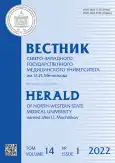Influence of risk factors for the development of cardiovascular diseases on the parameters of arterial stiffness in patients with arterial hypertension and atherosclerosis of different degrees of severity
- Authors: Sayganov S.A.1, Gumerova V.E.1, Gomonova V.V.1
-
Affiliations:
- North-Western State Medical University named after I.I. Mechnikov
- Issue: Vol 14, No 1 (2022)
- Pages: 69-76
- Section: Original study article
- URL: https://journals.rcsi.science/vszgmu/article/view/99754
- DOI: https://doi.org/10.17816/mechnikov99754
- ID: 99754
Cite item
Abstract
BACKGROUND: Arterial hypertension is widespread in the population, leads to the development of arteriosclerosis and increase of arterial stiffness, and is the main non-lipid risk factor of atherosclerosis development. Multiple studies have shown that increase of arterial stiffness is an independent risk factor for the development of cardiovascular events. However, the influence of traditional cardiovascular risk factors on arterial stiffness in arterial hypertension and atherosclerotic process of different degrees of severity has not been sufficiently studied.
AIM: To assess the influence of traditional risk factors on the parameters of arterial stiffness in patients with arterial hypertension (AH) and atherosclerotic process of varying degrees of severity.
MATERIALS AND METHODS: 133 subjects with AH have been divided into 3 groups depending on the severity of the atherosclerotic process. The control group included 33 individuals without known cardiovascular diseases. All the participants have undergone a standard clinical and laboratory examination, 24hr blood pressure monitoring with assessment of arterial stiffness (AS) parameters. The influence of risk factors on AS parameters has been analyzed for all the participants and separately by groups.
RESULTS: In the AH patients, an increase in the arterial stiffness index (ASI) is associated with an older age and an increase in systolic blood pressure (SBP); an increase in the augmentation index (AIx75) is associated with age; SBP in higher in women. Pulse wave velocity in the aorta (PWVao) is most associated with age, smoking, and family history in patients with hypertension and subclinical atherosclerosis. An increase in AIx75 is associated with an older age and is higher in women, while ASI has a positive relationship with age and SBP. In patients with hypertension and coronary artery disease, there is a positive correlation between male body mass index and PWVao. The increase in ASI in this group is associated with female gender, SBP and age. In individuals without hypertension and signs of atherosclerosis with a family history of CVD, PWVao values are higher than in similar individuals without a family history of CVD.
CONCLUSIONS: In the group of all the participants, female gender, smoking, an older age, SBP, and body mass index are associated with increased AS parameters. The association between risk factors and parameters of arterial stiffness has peculiarities in patients with hypertension with varying degrees of severity of the atherosclerotic process.
Full Text
##article.viewOnOriginalSite##About the authors
Sergey A. Sayganov
North-Western State Medical University named after I.I. Mechnikov
Email: sergey.sayganov@szgmu.ru
ORCID iD: 0000-0001-8325-1937
SPIN-code: 2174-6400
MD, Dr. Sci. (Med.), Professor
Russian Federation, 47, Piskarevsky Ave., Saint Petersburg, 195067Victoria E. Gumerova
North-Western State Medical University named after I.I. Mechnikov
Author for correspondence.
Email: vvoron1@yahoo.com
ORCID iD: 0000-0003-2805-3748
SPIN-code: 9872-4799
ResearcherId: ABG-7675-2020
Russian Federation, 47, Piskarevsky Ave., Saint Petersburg, 195067
Veronika V. Gomonova
North-Western State Medical University named after I.I. Mechnikov
Email: Veronika.Gomonova@szgmu.ru
ORCID iD: 0000-0002-9816-9896
SPIN-code: 6763-2979
Russian Federation, 47, Piskarevsky Ave., Saint Petersburg, 195067
References
- Benjamin EJ, Virani SS, Callaway CW, et al. Heart disease and stroke statistics-2018 update: a report from the american heart association. Circulation. 2018;137(12):67–492. doi: 10.1161/CIR.0000000000000558
- Ganelina IE, Lipovetsky BM, Tchurina SK, et al. Ateroskleroz venechnyh arterij i ishemicheskaja bolezn’ serdca. Uchebnoe posobie. 2nd ed. Saint-Petersburg; 2012. (In Russ.)
- Go AS, Mozaffarian D, Roger VL, et al. Heart Disease and Stroke Statistics-2014 Update: a Report From the American Heart Association. Circulation. 2014;129(3):e28–e292. doi: 10.1161/01.cir.0000441139.02102.80
- Ben-Shlomo Y, Spears M, Boustred C, et al. Aortic pulse wave velocity improves cardiovascular event prediction: an individual participant meta-analysis of prospective observational data from 17,635 subjects. J Am Coll Cardiol. 2014;63(7):636–646. doi: 10.1016/j.jacc.2013.09.063.80
- Ostroumova OD, Kochetkov AI, Kopchenov II, et al. The hardness of the vessel wall in patients with arterial hypertension. Systemic Hypertension. 2015;12(2):43–48. (In Russ.). doi: 10.26442/SG29073
- Korneva VA, Kuznetsova TY. Assessment of arterial wall stiffness by 24-hour blood pressure monitoring. Therapeutic Archive. 2016;88(9):119–124. (In Russ.). doi: 10.17116/terarkh2016889119-124
- Fujiyoshi A, Sekikawa A, Shin C, et al. A cross-sectional association of obesity with coronary calcium among Japanese, Koreans, Japanese Americans, and U.S. whites. Eur Heart J Cardiovasc Imaging. 2013;14(9):921–927. doi: 10.1093/ehjci/jet080
- Zachariah JP, Hwang S, Hamburg NM, et al. Circulating adipokines and vascular function: cross-sectional associations in a community-based cohort. Hypertension. 2016;67(2):294–300. doi: 10.1161/HYPERTENSIONAHA.115.05949
- Rossi P, Francès Y, Kingwell B, Ahimastos A. Gender differences in artery wall biomechanical properties throughout life. J Hypertens. 2011;29(6):1023–1033. doi: 10.1038/hr.2010.25
- Doonan RJ, Hausvater A, Scallan C, et al. The effect of smoking on arterial stiffness. Hypertens Res. 2010;33(5):398–410. doi: 10.1038/hr.2010.25
- Angoff R, Mosarla RC, Tsao CW. Aortic stiffness: epidemiology, risk factors, and relevant biomarkers. Front Cardiovasc Med. 2021;8:709396. doi: 10.3389/fcvm.2021.709396
- Laurent S, Boutouyrie P. Vascular ageing – state of play, gaps and key issues. Heart Lung Circ. 2021;30(11):1591–1594. doi: 10.1016/j.hlc.2021.06.528
- Gumerova VE, Sayganov SA, Gomonova VV. Parameters of arterial stiffness in hypertensive patients with and without subclinical carotid atherosclerosis. Arterial Hypertension. 2021;27(4):427–435. (In Russ.). doi: 10.18705/1607-419X-2021-27-4-427-435
- Fernández-Friera L, Penalvo J, Fernandez-Ortis A, et al. Prevalence, vascular distribution, and multiterritorial extent of subclinical atherosclerosis in a middle-aged cohort the PESA (Progression of Early Subclinical Atherosclerosis) study. Circulation. 2015;131(24):2104–2113. doi: 10.1161/CIRCULATIONAHA.114.014310
- Zhang Y, Fang X, Hua Y, et al. Carotid artery plaques, carotid intima–media thickness, and risk of cardiovascular events and all-cause death in older adults: A 5-Year Prospective, Community-Based Study. Angiology. 2018;69(2):120–129. doi: 10.1177/0003319717716842
- Shalnova SA, Deev AD. Russian mortality trends in the early XXI centure: official statistics data. Cardiovascular Therapy and Prevention. 2011;10(6):5–10. (In Russ.). doi: 10.15829/1728-8800-2011-6-5-10
Supplementary files









